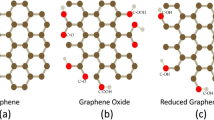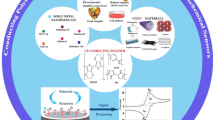Abstract
Here, we propose the novel fabrication of graphene–polymer (GP)-based quaternary nanocomposite and mesoporous (MS) nanomaterials sensor [\(\hbox {NaLa}(\hbox {MoO}_{\mathrm {4}})_{\mathrm {2}}\)-GO-PPy (NLMG-PPy), CuZnSnSe-GO-PPy (CZSG-PPy) and \(\hbox {In}_{\mathrm {2}}\hbox {O}_{\mathrm {3}}\)-G-\(\hbox {SiO}_{\mathrm {2}}\,20{\%}\) (IGS20)] to address ignored challenges for Escherichia coli bacteria recognition in polluted samples. Synthesized samples were characterized through X-ray diffraction (XRD), scanning electron microscopy (SEM), energy-dispersive X-ray spectrometry (EDX), transmission electron microscopy (TEM), high-resolution transmission electron microscopy (HRTEM), Raman spectroscopy, nitrogen adsorption–desorption isotherms, X-ray photoelectron spectroscopy (XPS) and diffuse reflectance spectroscopy (DRS). The sensor could recognize an individual E. coli cell in \(1\,\upmu \hbox {l}\) sample volume within 50 s. Through a low identification point of an individual cell, the MS and GP sensor had an absolute scope of 1–100 CFU per \(\upmu \hbox {l}\) volume of sample (i.e. \(10^{\mathrm {3}}\)–\(10^{\mathrm {5}}\,\hbox {CFU ml}^{\mathrm {-1}})\). The high thickness of negative charge on the surface of E. coli cells actively regulates the concentration of dominant part charge carriers in the mesoporous and G-polymer monolayer, permitting an ongoing check of E. coli concentration in a known sample. Our biosensor is simple and low-cost with great selectivity and fast identification was effectively shown for E. coli detection.

















Similar content being viewed by others
References
Abu-Ali H, Nabok A and Smith T J 2019 Anal. Bioanal. Chem. 411 7659
Acharya G, Chang C-L and Savran C 2006 J. Am. Chem. Soc.128 3862
Ahn J-H, Choi S-J, Han J-W, Park T J, Lee S Y and Choi Y-K 2010 Nano Lett.10 2934
Allen B L, Kichambare P D and Star A 2007 Adv. Mater.19 1439
Bulard E, Bouchet-Spinelli A, Chaud P, Roget A, Calemczuk R, Fort S et al 2015 Anal. Chem.87 1804
Cai B, Wang S, Huang L, Ning Y, Zhang Z and Zhang G-J 2014 ACS Nano8 2632
Campbell G A and Mutharasan R 2007 Environ. Sci. Technol.41 1668
Chang J, Mao S, Zhang Y, Cui S, Steeber D A and Chen J 2013a Biosens. Bioelectron. 42 186
Chang J, Mao S, Zhang Y, Cui S, Zhou G, Wu X et al 2013b Nanoscale5 3620
Chang J, Zhou G, Gao X, Mao S, Cui S, Ocola L E et al 2015 Sens. Bio-Sens. Res. 5 97
Chen J, Andler S M, Goddard J M, Nugen S R and Rotello V M 2017 Chem. Soc. Rev. 46 1272
Edberg S C, Rice E W, Karlin R J and Allen M J 2000 J. Appl. Microbiol. 88 106S
Geim A K and Novoselov K S 2007 Nat. Mater.6 183
Ghosh T, Biswas C, Oh J, Arabale G, Hwang T, Luong N D et al 2012 Chem. Mater.24 594
Hahn M A, Tabb J S and Krauss T D 2005 Anal. Chem.77 4861
Hassan A-R H A-A, de la Escosura-Muñiz A and Merkoçi A 2015 Biosens. Bioelectron. 67 511
He Q, Wu S, Yin Z and Zhang H 2012 Chem. Sci. 3 1764
Jazayeri M H, Amani H, Pourfatollah A A, Pazoki-Toroudi H and Sedighimoghaddam B 2016 Sens. Bio-Sens. Res. 9 (Supplement C) 17
Jung I, Diki D A, Piner R D and Ruoff R S 2008 Nano Lett.8 4283
Kang D-K, Ali M M, Zhang K, Huang S S, Peterson E, Digman M A et al 2014 Lab Chip5 5427
Kellici S, Acord J, Ball J, Reehal H S, Morgan D and Saha B 2014 RSC Adv. 4 14858
Kumar P V, Bardhan N M, Chen G-Y, Li Z, Belcher A M and Grossman J C 2016 Carbon100 (Supplement C) 90
Labib M, Zamay A S, Kolovskaya O S, Reshetneva I T, Zamay G S, Kibbee R J et al 2012 Anal. Chem.84 8966
Laczka O, Baldrich E, Muñoz F X and del Campo F J 2008 Anal. Chem.80 7239
Lee A, Mirrett S, Reller L B and Weinstein M P 2007 J. Clin. Microbiol.45 3546
Li F, Zhao Q, Wang C, Lu X, Li X-F and Le X C 2010 Anal. Chem.82 3399
Lim J Y, Yoon J W and Hovde C J 2010 J. Microbiol. Biotech.20 5
Marcano D C, Kosynkin D V, Berlin J M, Sinitskii A, Sun Z, Slesarev A et al 2010 ACS Nano4 4806
Martínez M T, Tseng Y-C, Ormategui N, Loinaz I, Eritja R and Bokor J 2009 Nano Lett.9 530
Miranda O R, Li X, Garcia-Gonzalez L, Zhu Z-J, Yan B, Bunz U H F et al 2011 J. Am. Chem. Soc.133 9650
Ohno Y, Maehashi K and Matsumoto K 2010 J. Am. Chem. Soc.132 18012
Pandey A, Gurbuz Y, Ozguz V, Niazi J H and Qureshi A 2017 Biosens. Bioelectron.91 225
Schedin F, Geim A K, Morozov S V, Hill E W, Blake P, Katsnelson M I et al 2007 Nat. Mater. 6 652
Schmid M, Shishkin M, Kresse G, Napetschnig E, Varga P, Kulawik M et al 2006 Phys. Rev. Lett.97 046101
Sepunaru L, Tschulik K, Batchelor-McAuley C, Gavish R and Compton R G 2015 Biomater. Sci. 3 816
Vanaja Sivapriya K, Russo Ashley J, Behl B, Banerjee I, Yankova M, Deshmukh Sachin D et al 2016 Cell165 1106
Wang Y, Knoll W and Dostalek J 2012 Anal. Chem.84 8345
Wu G, Meyyappan M and Lai K W C 2016 IEEE Nano22 25
Zhang Y, Tan Y-W, Stormer H L and Kim P 2005 Nature438 201
Zhao X, Hilliard L R, Mechery S J, Wang Y, Bagwe R P, Jin S et al 2004 Proc. Natl. Acad. Sci. USA101 15027
Zhou G, Chang J, Cui S, Pu H, Wen Z and Chen J 2014 ACS Appl. Mater. Interfaces6 19235
Zhu C, Yang G, Li H, Du D and Lin Y 2015 Anal. Chem. 87 230
Tan H L, Abdi F F and Ng Y H 2019 Chem. Soc. Rev.48 1255
Author information
Authors and Affiliations
Corresponding author
Electronic supplementary material
Below is the link to the electronic supplementary material.
Rights and permissions
About this article
Cite this article
Fatema, K.N., Biswas, M.R.U.D., Bang, S.H. et al. Electroanalytical characteristic of a novel biosensor designed with graphene–polymer-based quaternary and mesoporous nanomaterials. Bull Mater Sci 43, 121 (2020). https://doi.org/10.1007/s12034-020-02090-x
Received:
Accepted:
Published:
DOI: https://doi.org/10.1007/s12034-020-02090-x




